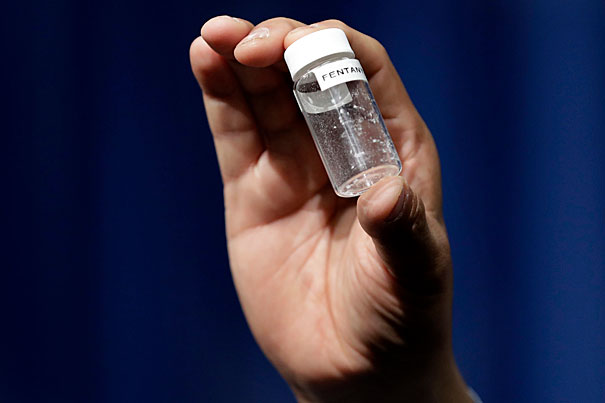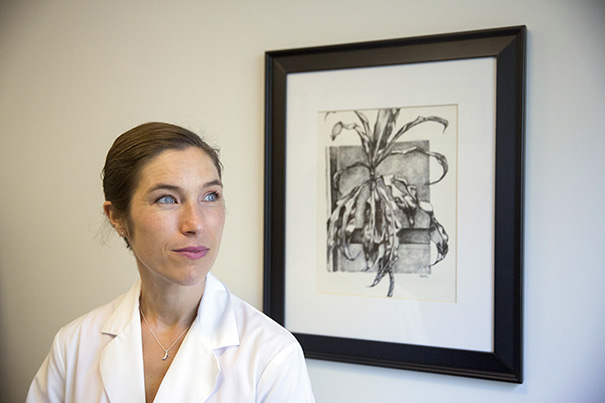
A reporter displays the volumetric equivalent of a fatal dose of fentanyl, a potent synthetic opioid that is being cut with heroin and posing greater risk to users and even first responders.
Photo by Jacquelyn Martin/AP
Rising threat: Death by fentanyl
MGH addiction specialist explains synthetic opioid’s role in U.S. epidemic
As the opioid crisis rages across the United States, people suffering from addiction as well as the first responders, doctors, and counselors trying to help them are facing another deadly challenge: fentanyl, a synthetic opioid 100 times more powerful than heroin and a growing part of the nation’s illicit drug supply.
The Gazette recently spoke with Sarah Wakeman, medical director of the Substance Use Disorder Initiative and the Addiction Consult Team at Harvard-affiliated Massachusetts General Hospital (MGH), co-chair of the MGH Opioid Task Force, and clinical lead for the Partners Healthcare Substance Use Disorder Initiative, about fentanyl and the country’s opioid epidemic.
GAZETTE: What is fentanyl?
WAKEMAN: Fentanyl is a synthetic opioid. “Opioid” is the umbrella term that refers to any substance that is chemically similar to opium, which comes from a poppy and which acts on a certain part of the brain — the opioid receptor. So fentanyl is a type of opioid that is made completely synthetically, meaning it’s made in a laboratory and is much more potent than heroin or morphine. It’s about 100 times more potent than morphine.
GAZETTE: Is fentanyl something that you have been observing for years in patients being treated for addiction, or has it appeared more recently?
WAKEMAN: The widespread sale of illicitly manufactured fentanyl, which is what we are hearing about right now, is a relatively recent phenomenon. It’s really in the last two or so years that we have seen this rapid growth in the manufacture and sale of fentanyl and other synthetic fentanyl analogues. Much of what is being sold as heroin now is either mixed with fentanyl or pure fentanyl. Prescription fentanyl has been around for a long time and there are numerous studies looking at people who used prescription fentanyl for nonmedical reasons, but those numbers were relatively low and never accounted for much of a problem until we began seeing the heroin source contaminated with fentanyl.
GAZETTE: Why are we seeing more of it?
WAKEMAN: This is emblematic of the cat-and-mouse game of supply-focused drug crackdown efforts. Because fentanyl is so potent you need a much smaller amount of it to have the same effects, and so the margin of profits is much greater. People can produce or smuggle in a much smaller volume of the drug and then cut it with other substances and sell it for a higher profit. So you can imagine if it’s 100 times more potent than heroin, you need 100 less times the amount of volume to get the same sort of profit, so people are mixing it with other filler substances and then selling it as heroin.

GAZETTE: What are the challenges of treating fentanyl overdoses?
WAKEMAN: In addition to fentanyl we are now seeing even a more potent synthetic fentanyl analogue — carfentanil, which is something that’s been in the press with recent reports of carfentanil being found in Massachusetts. It’s 10,000 times more potent than heroin. It’s actually used as a large animal tranquilizer — that’s the only practical use carfentanil was designed for. But we are now seeing that contaminating the supply as well.
First, when we teach people in the community or people who either use opioids themselves or love someone or care for someone who has an opioid-use disorder how to respond to an overdose, the traditional teaching was that you had minutes to hours before someone would die from an overdose, and so there was time to get naloxone, the drug that can reverse an overdose, call 911, and get help. Part of the challenge with these new substances is that people can die within a few seconds. So the rapidity of how fatal these substances can be is totally different, and overdoses now require immediate, rapid response. Second, this increases the stakes of untreated opioid-use disorder. Literally, any day that someone is using could be a day that they die, and the person who is using has no idea what it is that they are about to use. In the past we could provide harm-reduction education to people about how to use in a safer fashion, but that’s much more challenging when the substance that they are using could be what they expect or it could be something that’s 10,000 times more powerful and could kill them on the spot. This really emphasizes the need for immediate access to effective treatment for opioid-use disorder. Additionally, we need innovative ideas such as supervised injection facilities to keep people who are using safe and alive with the ultimate hope that we can connect them to treatment.
GAZETTE: Does treatment for opioid-use disorder change now that the drug supply is increasingly contaminated with fentanyl?
WAKEMAN: The treatment would be the same as the treatment for any opioid-use disorder where the best evidence we have supports a combination of medication and psychosocial or behavioral treatments. Medications like methadone or buprenorphine, which are daily medications someone takes to manage their cravings and prevent withdrawal and allow them to function normally, are the standard of care. The challenge is that our systems of care are outdated as well. We traditionally have had a treatment system that expects people to be able to navigate complicated waiting lists, to call programs, to schedule appointments, and to show up to counseling before they get life-saving medication. The reality right now is that people are literally dying every day and any episode of use could kill them, so we really need to rethink our treatment systems and we need to make lifesaving treatments, medications in particular, as easy to access as possible. Let’s get people on the medication that will keep them alive and then build infrastructure around that instead of making it hard for people to get that sort of care.
More like this
GAZETTE: First responders have to be extremely careful about coming into contact with fentanyl. Can you say more about that?
WAKEMAN: These substances, particularly carfentanil, are so potent that even a few grains, if they are absorbed, could in theory cause an overdose, particularly in someone who is naive to opioids. The impact on first responders is huge. They now not only need to wear gloves but potentially need to wear masks because there’s been concern that these substances can cause an overdose simply by inhaling the dust at the scene of one of these events.
GAZETTE: A recent report in The New York Times indicated that overdose deaths in the United States are rising faster than ever. Is fentanyl a big factor in those statistics?
WAKEMAN: Absolutely — I think that’s really what’s driving the deaths right now. If you look at last year’s deaths in Massachusetts, something like 85 percent were due to heroin and fentanyl versus fewer than 10 percent that were due to someone being prescribed an opioid. We’ve had a lot of focus on prescription opioids as something that lay the groundwork for the current epidemic of opioid use disorder and death, but if you look at what’s sustaining the epidemic, what’s sustaining the deaths, it’s really fentanyl and heroin. We are seeing that across the country and we certainly are seeing that in Massachusetts.
GAZETTE: In March President Trump signed an executive order appointing New Jersey Gov. Chris Christie as the head of a new national commission designed to fight opioid addiction. Meanwhile, Attorney General Jeff Sessions has signaled his plans to aggressively prosecute low-level drug crimes. What is your sense about how the medical community views these messages from the new administration?
WAKEMAN: It is incredibly disheartening to hear further focus on the old-school tactics of the war on drugs. So far we’ve heard the attorney general mention bringing back mandatory minimum sentences and a stronger focus on the criminalization approach to drug use, which has never worked. We’ve been trying that approach for a long time and what we’ve seen is that drugs are easier to access; they are more potent and more deadly and more people are dying from drug addiction and drug use. That strategy has been wholly ineffective. If anything it drives people away from treatment and increases the stakes of ongoing drug use and increases crime. To hear our government talk about doubling down on a harmful and ineffective strategy in the midst of a crisis is really discouraging. This approach also plays on the false notion that you can somehow clearly separate people who deal drugs and people who use drugs, when the reality is many people who in fact have the disease of addiction are dealing drugs on some level. And beyond that, the growth of fentanyl is evidence of the failure of supply-focused efforts. The tactics of people who are out for profit with drug dealing will continue to change under pressure and the outcome is not that drugs are harder to get but that people are dying at a greater rate.
What has been shown to work is to not criminalize drug use and addiction and instead to focus on treatment and public health and harm reduction. I think we were all hopeful — particularly with the former surgeon general’s report — that our country was heading in that direction. I am still hopeful because the science is so clear about what is effective. President Trump campaigned on the opioid crisis and many people who voted for him come from areas that have been devastated by the impact of this disease. My hope is that his administration will decide to focus on what works, not on politics or ideology.
GAZETTE: What would you like to see Trump do?
WAKEMAN: I think the first thing involves a separate but very related issue — the Affordable Care Act, which importantly expanded coverage for addiction treatment. If the ACA is repealed a huge number of people who have this disease won’t be able to access treatment. To even be able to focus on treatment people need to have insurance coverage that allows them to access it, so that’s a really important piece.
The other thing is to have conversations about types of treatment for opioid-use disorder guided by science. We heard Health and Human Services Secretary Tom Price make comments recently where he referred to medications for addiction treatment as the substituting of one substance for another. This is an old, untrue, and stigmatizing belief that misunderstands what addiction is. This stigma around medications has kept people out there using and has kept people dying. We need statements by our leaders in government and health care to be guided by facts, not by belief. We need to be having a conversation guided by science and what works to keep people alive and to keep people well.
Drug use and addiction is a very politicized topic. People have strong emotions and feelings about it, which is understandable. But we also have 50 years or more of very clear evidence showing what works and what doesn’t. Let’s stick to what works, particularly right now when this is the leading cause of death for Americans under age 50.
Interview was edited and condensed.





